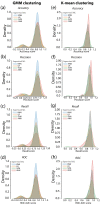Towards a machine-learning assisted diagnosis of psychiatric disorders and their operationalization in preclinical research: Evidence from studies on addiction-like behaviour in individual rats
- PMID: 36215170
- PMCID: PMC10092243
- DOI: 10.1111/ejn.15839
Towards a machine-learning assisted diagnosis of psychiatric disorders and their operationalization in preclinical research: Evidence from studies on addiction-like behaviour in individual rats
Abstract
Over the last few decades, there has been a progressive transition from a categorical to a dimensional approach to psychiatric disorders. Especially in the case of substance use disorders, interest in the individual vulnerability to transition from controlled to compulsive drug taking warrants the development of novel dimension-based objective stratification tools. Here we drew on a multidimensional preclinical model of addiction, namely the 3-criteria model, previously developed to identify the neurobehavioural basis of the individual's vulnerability to switch from controlled to compulsive drug taking, to test a machine-learning assisted classifier objectively to identify individual subjects as vulnerable/resistant to addiction. Datasets from our previous studies on addiction-like behaviour for cocaine or alcohol were fed into a variety of machine-learning algorithms to develop a classifier that identifies resilient and vulnerable rats with high precision and reproducibility irrespective of the cohort to which they belong. A classifier based on K-median or K-mean-clustering (for cocaine or alcohol, respectively) followed by artificial neural networks emerged as a highly reliable and accurate tool to predict if a single rat is vulnerable/resilient to addiction. Thus, each rat previously characterized as displaying 0-criterion (i.e., resilient) or 3-criteria (i.e., vulnerable) in individual cohorts was correctly labelled by this classifier. The present machine-learning-based classifier objectively labels single individuals as resilient or vulnerable to developing addiction-like behaviour in a multisymptomatic preclinical model of addiction-like behaviour in rats. This novel dimension-based classifier increases the heuristic value of these preclinical models while providing proof of principle to deploy similar tools for the future of diagnosis of psychiatric disorders.
Keywords: addiction; clustering; individual vulnerability; machine learning; neural networks; substance use disorder.
© 2022 The Authors. European Journal of Neuroscience published by Federation of European Neuroscience Societies and John Wiley & Sons Ltd.
Conflict of interest statement
The authors declare no competing financial interests.
Figures





Similar articles
-
Environment-dependent behavioral traits and experiential factors shape addiction vulnerability.Eur J Neurosci. 2021 Mar;53(6):1794-1808. doi: 10.1111/ejn.15087. Epub 2021 Jan 12. Eur J Neurosci. 2021. PMID: 33332672
-
Differential expression of miR-1249-3p and miR-34b-5p between vulnerable and resilient phenotypes of cocaine addiction.Addict Biol. 2022 Sep;27(5):e13201. doi: 10.1111/adb.13201. Addict Biol. 2022. PMID: 36001423 Free PMC article.
-
Linking drug and food addiction via compulsive appetite.Br J Pharmacol. 2022 Jun;179(11):2589-2609. doi: 10.1111/bph.15797. Epub 2022 Mar 7. Br J Pharmacol. 2022. PMID: 35023154 Free PMC article.
-
Individual differences in cocaine addiction: maladaptive behavioural traits.Addict Biol. 2014 Jul;19(4):517-28. doi: 10.1111/adb.12036. Epub 2013 Jan 25. Addict Biol. 2014. PMID: 24835358 Review.
-
Responses to novelty and vulnerability to cocaine addiction: contribution of a multi-symptomatic animal model.Cold Spring Harb Perspect Med. 2012 Nov 1;2(11):a011940. doi: 10.1101/cshperspect.a011940. Cold Spring Harb Perspect Med. 2012. PMID: 23125204 Free PMC article. Review.
Cited by
-
Categorized and individualized behavioral phenotyping approaches for control and triple-hit schizophrenia-like model rats in acute and chronic reward-based systems: A pilot study.PLoS One. 2025 Aug 7;20(8):e0328460. doi: 10.1371/journal.pone.0328460. eCollection 2025. PLoS One. 2025. PMID: 40773442 Free PMC article.
-
Listening to the Data: Computational Approaches to Addiction and Learning.J Neurosci. 2023 Nov 8;43(45):7547-7553. doi: 10.1523/JNEUROSCI.1415-23.2023. J Neurosci. 2023. PMID: 37940590 Free PMC article. Review.
References
-
- Anthony, J. C. , Warner, L. A. , & Kessler, R. C. (1994). Comparative epidemiology of dependence on tobacco, alcohol, controlled substances, and inhalants: Basic findings from the National Comorbidity Survey. Experimental and Clinical Psychopharmacology, 2, 244–268. 10.1037/1064-1297.2.3.244 - DOI
-
- APA . (1994). Diagnostic and statistical manual of mental disorders ‐ DSM IV. American Psychiatric Association.
-
- APA . (2013). The diagnostic and statistical manual of mental disorders: DSM 5. bookpointUS. - PubMed

